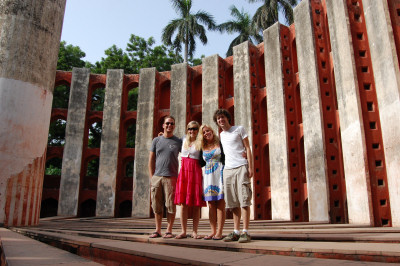Monday morning marked the start of our lecture series at XIME. We all had a great holiday weekend, and The University of Redlands students have now arrived. We began our day with a welcome and introduction session where we had formal introductions and discussions on our expectations for our time at XIME.
Professor Ravindranathan began with a discussion of the Indian economic scene. India’s growth is exponential and second only to China. While they were impacted by the recent financial crisis, not to the extent that the US was. It is projected that if their growth stays between 5 and 10 percent over the next 40 years, they will be 3rd largest in terms of GDP. Their concerns as a nation are obvious – the literacy rate is about 66 percent and of those, many are barely literate. They also have 260 million people who are below the poverty line. Sixty percent of the population is tied to agriculture, yet it makes up less than 20 percent of the GDP. They also have a very difficult regulatory environment. They have hopes for their nation to eliminate poverty by 2015, commercialize agriculture, and create more jobs by attracting more industry.
After a very nice welcome lunch with the faculty, we visited with a tooling company called TaeguTec. Their parent company is based in South Korea, and they came to Bangalore in 2010. They house an impressive facility with the latest technology and innovations. We were given a very thorough tour and had a nice discussion period after on doing business in India. The biggest takeaway from this company visit was that it may not always be easy to do business in India, but it is always possible. There may be some bumps in the road, but you can work through them.
Following our company visit, Professor Iyengar joined us for a lecture on Indian society and culture. Many of the same characteristics stood out in this discussion as did in our morning lecture. He described India as a salad bowl – a culture of people coexisting, but maintaining individuality. We learned that 83 percent of the population is of the Hindu faith, but that it encompasses a diverse range of beliefs. We learned that India is one-third the land area of the US, but 4 times the population. They are the largest democracy in the world and an unlikely one at that. It was expected that India would disintegrate as a democracy. There are 18 major languages, including Hindi spoken by about 40 percent of the population mostly in the north. English, however, is the linking language and used in business and communications. The professor compared India to an elephant, slow and steady, while China is like a dragon, fast and furious. We discussed the remnants of the caste system and the patriarchal nature of society. While the traditional values have somewhat changed, Indian society is still very hierarchical in nature. We concluded by discussing women’s role in society and how it has changed. Overall, our lectures were very engaging and interesting.
We ended our day by attending a cultural show put on by XIME students in our honor. They had singing, dancing, and videos representing Indian culture. It was really very nice, and we stayed to meet some of the students afterwards. It was a great day.
